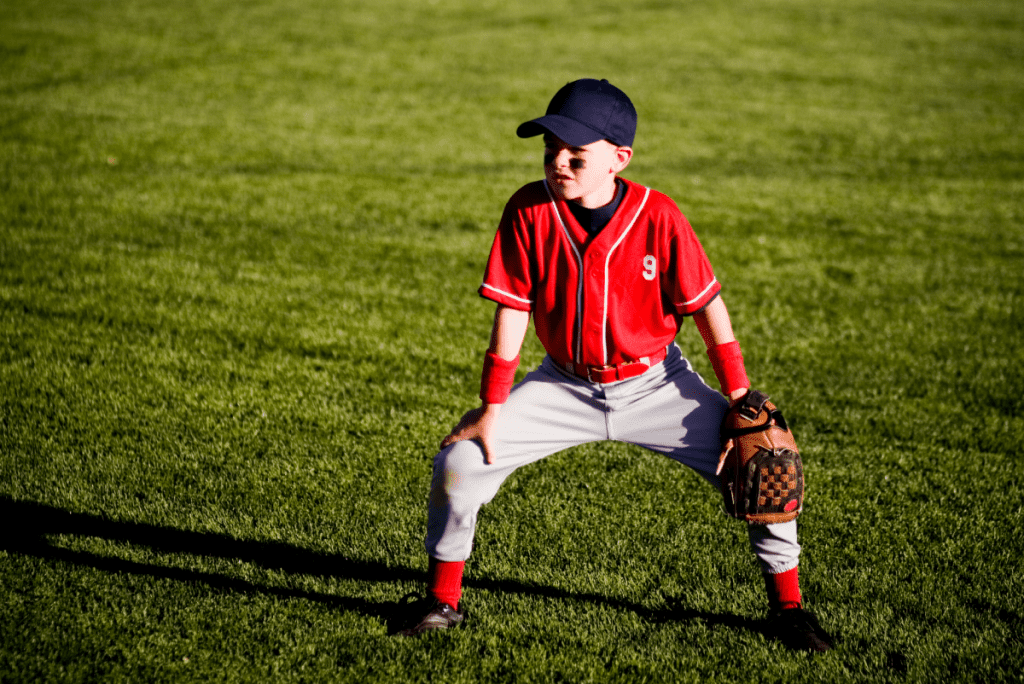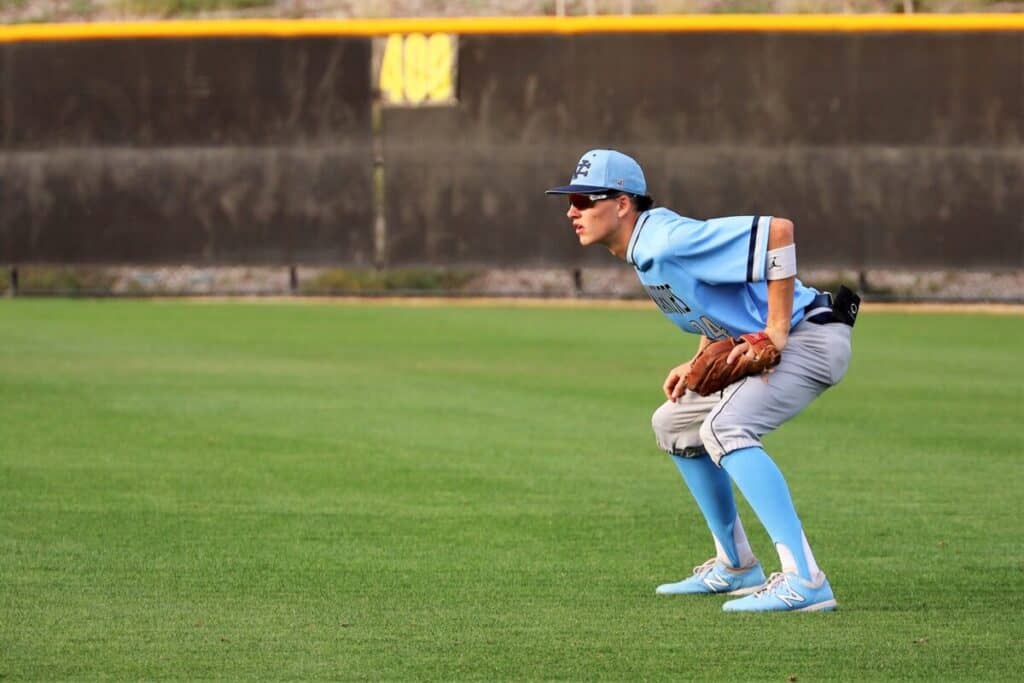Even if they’re unfamiliar with the term, anyone who has spent even a small amount of time watching baseball players settle into their familiar defensive crouch should be familiar with baseball’s “ready position”. MLB fielders have to be able to react to balls hit in their direction at well over a hundred miles an hour, often having to make a read on a ball in a fraction of a second, so how are they able to do it so routinely? A big part of any fielder’s ability to make spectacular plays relies on how they get prepared for each pitch by getting into their ready position.
The ready position in baseball is the stance a fielder takes during the delivery of a pitch which allows them to be in the optimal position to react to a ball hit in any direction. Most fielders use the athletic stance, with their knees slightly bent, hips back, and shoulders over their toes.

Cultivating a good defensive ready position may seem like a minute and prosaic detail, but it is an important tool in the player’s toolbox.
In fact, in an interview with Alex Rodriguez for ESPN’s Sunday Night Baseball, Carlos Correa credits a revamped ready position with his improvement as a fielder. This tool, like any other, requires constant refinement and practice in order to stay sharp, even at the major league level. And it turns out that the ready position is a different technique for each position.
Article Contents
What Does a Good Ready Position Look Like?
Looking around a baseball field you will quickly realize that a good ready position looks different depending on what position you are fielding.

For example, a shortstop and a center fielder will have very different ready positions even though they both play in the middle of the field. This makes sense, as different positions require different skills. However, they should all focus on making the fielder balanced and ready to react at the potential moment of contact from the hitter.
In order to facilitate this, there are both physical and mental aspects to consider. Let’s first look at what a good ready position looks like for different position groups below.
Good Ready Position for a Catcher:

Catchers are unique fielders in that they know that they will likely be involved in every play, even if there isn’t a hit, as they are catching every pitch.
Because of their position, a catcher must be in a defensive squat to receive pitches thrown inside the strike zone while also remaining agile enough to defend and block the plate from errant pitches or the opposing teams’ runners. This means catchers have a unique ready position known as a catcher’s stance.
A good catcher’s stance should focus on the following:
- The throwing hand should be in a fist and behind the back, behind the heel, or to the side of the groin. This is to protect your throwing hand from foul balls.
- Keep your hips open by settling into your crouch with your toes out, keep your feet about shoulder-width apart.
- Keep the chest up, which will take practice, especially if you are in a higher catcher’s stance with runners on base.
- Keep your glove in front of your knees. The glove should be open and presented as a target for the pitcher.
Good Ready Position for a Pitcher:
It may surprise some that the player tasked with pitching the ball should also be ready to field it coming back at them, but pitchers are just as valuable of fielders as any of the eight other positions on the field. So, pitchers also need to be ready to field balls by using their own basic ready stance.
- A pitcher should finish their delivery with both their head and body facing home plate, this will give them the best opportunity to field a ball coming back at them.
- In the moments between delivering a pitch and potential contact; a pitcher should move their glove to the center of their chest, this will give them the best protection from hard-hit balls to their body.
- Once the ball is hit, the pitcher should be in an athletic stance so they can quickly react to any hit
For a great example of a pitcher always being ready to field the ball, check out the video below of Greg Maddux making plays on balls hit up the middle. This is the highlight reel of a man who knows that a good defensive play is capable of erasing a potential hit and making a win easier for everyone involved.
Good Ready Position for Infielders:
Infielders are the closest non-pitching or catching fielders to the action. Because they are close to the hitter, they have to be ready to field the ball and know exactly what they will do with it before the hitter even takes a swing.

The basics of the infielders’ ready position should include:
- A light crouch with knees bent and legs turned slightly outward, similar in appearance to what a wrestler looks like in their grappling position.
- Encourage players to get in the habit of dropping their glove as the ball is pitched in order to gain better momentum for a good first step when breaking towards a ball.
- More advanced players can hop into their ready position to remain light on their feet.
- Corner infielders should be balanced away from the foul lines and ready to break towards the center of the field.
- Middle infielders should try to remain low and maintain energy to spring towards the ball no matter what side the ball is hit.
A good ready position is crucial for any infielder and can add many feet to a player’s natural range. For a visual of what a ready position looks like, check out the video below from Baseball Factory.
Good Ready Position for Outfielders:
On first thought, one may think outfielders have no need for a ready position, as they are so far away from the batter and should have plenty of time to react. But, those spectacular diving catches are only possible because of a good ready position that allows outfielders to read the ball off the bat and quickly break toward the ball.

Good outfielders should concentrate on the following when improving their ready position:
- Keep your legs moving in between pitches, even if the ball isn’t hit your way, this will keep you light on your feet and ready to field when the ball does eventually come your way.
- Prepare your body to react to a hit by dropping into an athletic stance.
- As the ball is pitched, keep your hands off your knees, legs bent, and knees broader than your shoulders. This looks similar to a defensive crouch one would see used by a football player or basketball player.
The Mental Aspect of Ready Position
As you can see from above, the physical parts of the ready position are clearly important, but of equal importance is the mental work that goes into a player’s ready position. Mental preparation is what separates good ballplayers from great ballplayers.
Some tips for mental preparation that apply to the fielding of any position include:
- Stay mentally sharp by reminding yourself of the count and situation after every pitch. If it helps to motivate yourself to stay present in the moment, you can communicate this to your teammates with gestures.
- Envision the ball being hit towards you; think of where you will throw it and how that will change depending on the situation. What would you do if the ball is a ground ball vs a fly ball?
- Watch the signals being relayed to the pitcher and catcher to know what your specific defensive assignment is.
- Prepare to field or cover for other fielders; mentally recognize what positions you need to back up with no runners on base vs runners on base.
- Mentally welcome the ball to be hit towards you. If you have truly mentally prepared for the ball to be hit your way then you are ready for any and all possibilities. Always welcome the ball and the opportunity to make an out.
As you can see, the mental aspect of the ready position is just as important as the physical preparation. In fact, mental preparation may be the difference between a hit and an out.
7 thoughts on “What is the Ready Position in Baseball?”
Comments are closed.